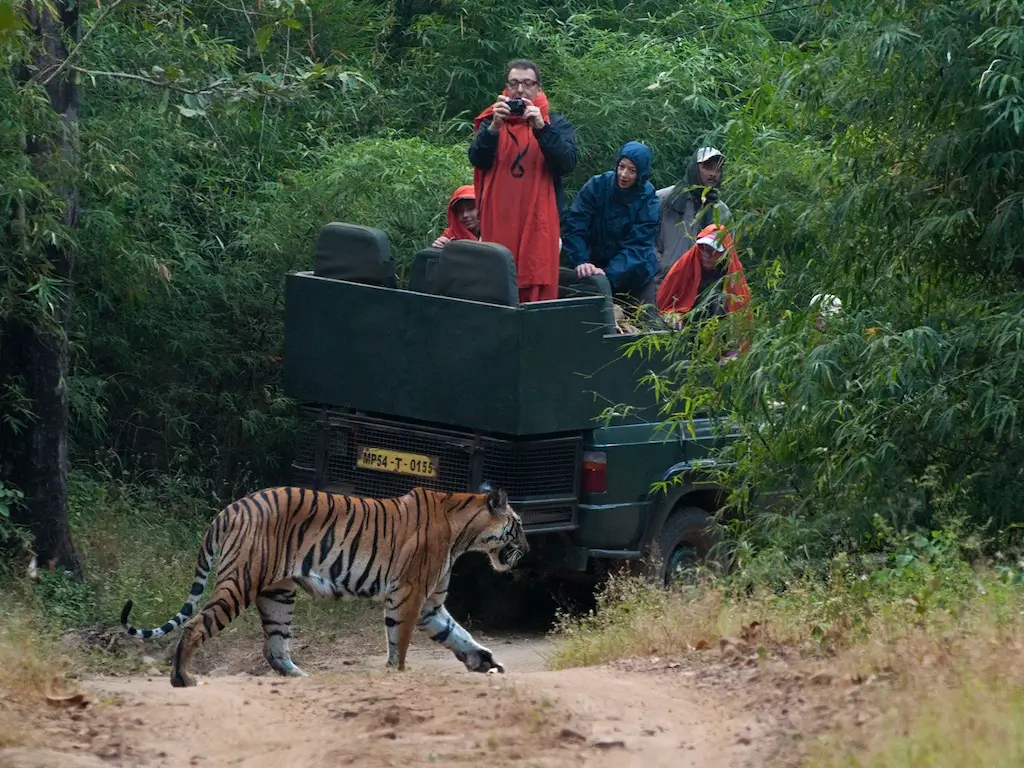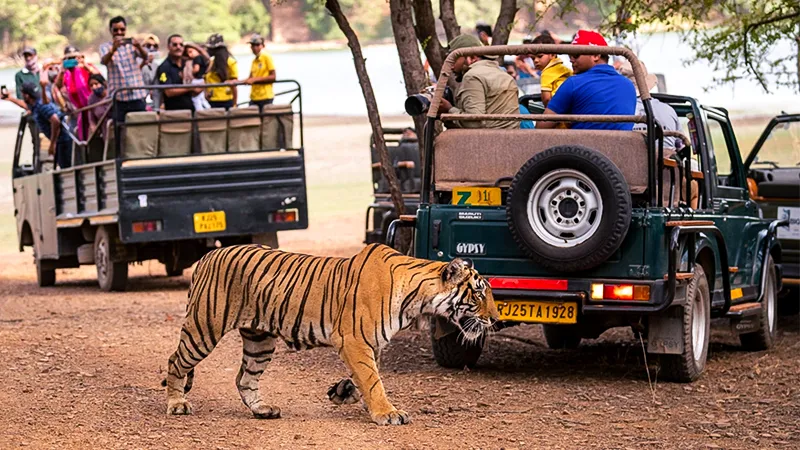When booking a tiger safari in India, many of our guests have a wide range of questions about safaris, accommodations, food, travel costs, and the best time to visit. Below is a comprehensive list of the top 10 questions we regularly receive, along with detailed answers from our team of experts at Oyepedia Travel LLP.
-
What is the best time to go on a tiger safari in India?

The best time to embark on a tiger safari in India can vary depending on your preferences. If you’re a wildlife photographer looking for the ideal conditions, we suggest planning your visit during the winter months, from November to February. The cool temperatures and misty mornings add a unique charm to the jungle, making it a great time to capture tigers against the vibrant backdrop of the forest. On the other hand, if you’re keen on observing more tiger activity and spotting prey in the dry season, the summer months (March to May) are perfect. During these months, tigers are more often seen near waterholes, as the prey concentrates there due to the heat. This leads to more sightings, though the parks tend to be busier. Whether you’re into photography or wildlife watching, both seasons offer distinct advantages.
-
Which National Park in India Offers the Best Tiger Safari Experience??
Choosing the best national park for a tiger safari depends on your interests and the kind of experience you seek. For those looking for a pristine jungle experience with the chance to witness some of the largest tigers in India, Kanha National Park is a top choice. This park offers a blend of lush forests and open meadows, making it a haven for tiger enthusiasts. If you’re after a diverse wildlife experience, Corbett National Park in Uttarakhand should be on your list. It’s not only home to tigers but also offers sightings of elephants, leopards, and over 350 species of birds. For an open and easy tiger-viewing experience, Ranthambore National Park is ideal, especially if you’re also interested in exploring India’s Golden Triangle (Delhi, Jaipur, and Agra). Each park has its own unique charm and offers different aspects of the Indian wilderness, making it worth exploring various options based on your preferences.
-
What is the Price of a Tiger Safari in India?

The cost of a tiger safari in India can vary significantly based on several factors such as the number of people traveling, the duration of the safari, the parks you visit, the accommodation type, and whether you prefer shared or exclusive safaris. For instance, luxury accommodations and exclusive safari experiences will naturally cost more. To get a precise estimate, you can share your preferences with us at Oyepedia Travel LLP, and we’ll craft a personalized safari experience that fits your budget and travel style.
-
What types of accommodations are available during a tiger safari in India?
Accommodations during a tiger safari can range from basic to luxurious, depending on your preferences and budget. National parks in India offer everything from simple forest rest houses to high-end wildlife resorts. For example, in Corbett National Park, you can stay at a historic forest rest house near the Ramganga River, where you’ll enjoy a rustic experience with minimal amenities. On the luxury side, resorts like Taj Banjaar Tola in Kanha and The Oberoi Vanyavilas in Ranthambore provide world-class facilities and impeccable service. Whether you’re looking for a rustic jungle retreat or a lavish stay, there are options to suit all tastes.
-
What kind of camera equipment can I carry during a tiger safari in India?

Most national parks in India allow you to carry a range of camera equipment, from basic point-and-shoot cameras to professional lenses. If you’re a wildlife photographer, we recommend bringing lenses like 70-200mm or even longer focal lengths such as 400mm, 500mm, or 600mm for close-up shots of tigers and other wildlife. At Oyepedia Travel LLP, we provide bean bags to help stabilize your cameras during the safari. However, keep in mind that some parks, like Sasan Gir and Tadoba, may charge a camera fee or restrict professional equipment. Additionally, drones and aerial photography are strictly prohibited for safety reasons.
-
Is Wi-Fi available at jungle resorts?
Yes, most jungle resorts in India now offer Wi-Fi in common areas such as the reception, dining hall, and lounge. In some resorts, the Wi-Fi extends to the rooms as well. However, we encourage you to disconnect from technology during your safari and immerse yourself in the natural beauty around you. The true essence of a jungle safari lies in experiencing the wilderness up close and personal, so we recommend enjoying the moment without the distractions of modern technology.
-
What kind of food is available at jungle lodges?
Jungle lodges in India offer a wide variety of cuisines to cater to different tastes and dietary preferences. You’ll find buffet-style breakfasts, set-menu lunches, and dinners at most resorts. Many lodges also accommodate special dietary requirements, whether you’re vegetarian, vegan, or have specific food preferences. The chefs are often happy to tailor meals to suit your needs, ensuring you enjoy a delightful culinary experience during your stay.
-
How many people share a safari vehicle?

In India, safari vehicles typically seat up to 6 people. You can either opt for a shared safari, where you might be joined by other guests, or an exclusive safari, where only you and your group will be in the jeep with a driver and guide. While shared safaris are more cost-effective, exclusive safaris provide a more personalized experience, ensuring the guide’s full attention and a more peaceful experience with fewer distractions.
-
Can I tip in foreign currency during the safari?
While tipping in foreign currencies like USD, EUR, or GBP is accepted, it is best to tip in the local currency to avoid any hassle for the locals in converting the foreign money. It’s always a kind gesture to show your appreciation for the services provided by the guides and drivers who enhance your safari experience.
-
Are mobile phones allowed inside national parks?
Yes, most national parks in India allow mobile phones, but they must be kept on silent or airplane mode to avoid disturbing the wildlife. Any noise can affect animal behavior and hinder your safari experience, so we advise you to keep your phone discreet during your jungle adventures.
At Oyepedia Travel LLP, we aim to ensure you have a seamless and memorable tiger safari experience. Feel free to reach out to us with any specific queries or to plan your next wildlife adventure in India!

